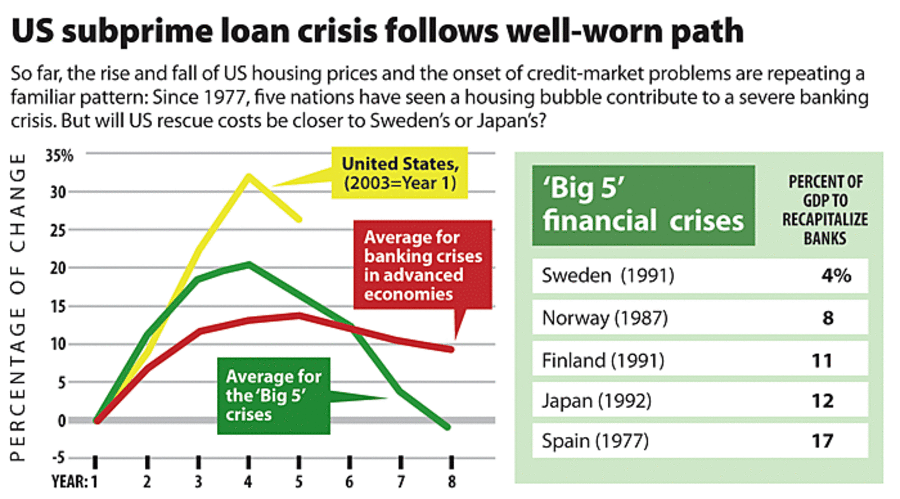Can U.S. avert a Japan-style economic bust?
Loading...
From Japan to Sweden, other nations have traveled from real estate busts to financial crises in recent years, leaving behind a simple lesson: Effective policy makes the difference between a long or a slow recovery.
For US policymakers, Japan is the case study in what not to do when a credit bubble is followed by a real estate bust. Regulatory delay resulted in a "lost decade" of economic stagnation there.
Sweden faced similar challenges but now serves as a model for how decisive action can mend a banking system.
So far this year, the Federal Reserve has already moved in creative ways in a bid to contain what may be America's worst financial crisis since the Great Depression. Its most recent actions brought a measure of calm to Wall Street this week.
But finance experts say the fundamental problem – the burden of bad loans on financial firms – still needs to be worked through. Future steps will determine whether America follows the Japanese or the Swedish path.
"If you're shoving it under the rug, then it's going to take you 10 years, like it did in Japan," says Carmen Reinhart, a University of Maryland economist. America's situation "can best be called the Japanese problem....
The scale and scope of the losses are as yet unknown."
Federal Reserve and other US policymakers are certainly aware of the Japanese precedent and want to avoid it.
But the scale of the problem, Ms. Reinhart says, is larger and more complex than the challenges faced by Sweden and other Scandinavian nations nearly two decades ago.
That doesn't mean the outcome will be catastrophic – thanks in part to the lessons policymakers have learned.
"My best hope, and I put no more than 40 percent probability on the outcome, is that we are amidst a protracted slow patch," rather than a recession, Reinhart said last month at a congressional hearing.
In any case, the US appears to be following a familiar pattern. Reinhart and Kenneth Rogoff of Harvard University have analyzed recent financial crises in advanced economies.
The common progression begins with a housing boom, money flowing in from overseas, and rising government debt. Then economic growth cools and banks see a rise in delinquent loans. The lenders tighten up on credit, further squeezing the economy. Often the result is a severe recession..
"The Japanese example is a terrific model of how not to do it," says David Beim, a former banker now at Columbia University's business school. "They had huge problems in their banks and they didn't face up to them."
For too long, experts say, Japanese regulators coddled ailing banks, hoping the problem would go away. The government tried to pump money into the system, but without demanding better management. Credit became largely unavailable to firms that could have used it productively.
That broke the rules of bank rescue.
"If the government must bail the bank out … it should basically wipe out the management and wipe out the shareholders," says Mr. Beim.
It sounds tough, but that's the point. It sends a signal that bad management won't be rewarded. And it conserves the bank's remaining resources – and taxpayer money – to restore sound lending for the economy.
Swedish regulators quickly determined that they would follow that path, as some of their largest banks collapsed in the early 1990s.
The US also did a decent job along these lines, Beim says, when many banks failed in the late 1980s and early '90s. (By contrast, earlier in the 1980s US policymakers tried to help ailing savings-and-loan institutions by altering regulations – and eventual mop-up became much more costly for taxpayers.)
Is a wave of bank implosions coming in the US?
"There probably will be some bank failures," Federal Reserve Chairman Ben Bernanke told Congress in February.
Much depends on whether a recession makes it harder for firms and consumers to keep paying off their loans.
Risks are already rising. The percentage of bank loans that are noncurrent is 1.39 percent, a six-year high, according to Yardeni Research Inc., citing federal reports. And banks' "return on assets" (another gauge of performance) was just 0.18 percent in the most recent quarter, the lowest since 1990.
A key concern for banks now is uncertainty over the real value of mortgage loans and the structured investments that contain those loans.
"There are losses buried everywhere" on balance sheets, Beim says. "It's all over the globe."
Faced with a comparable problem, Sweden "had a 'board of valuation' experts go in and value the assets," the loans at banks, according to David Rosenberg, chief economist at Merrill Lynch. And when a bank failed, the Swedish regulators reorganized the institution with "good" loans and "bad" loans under separate managements.
"Such a restructuring," he writes in a new report, "can provide an effective means for disposing of nonperforming loans and return the financial sector back to health."





